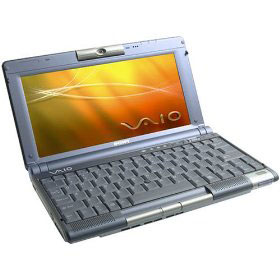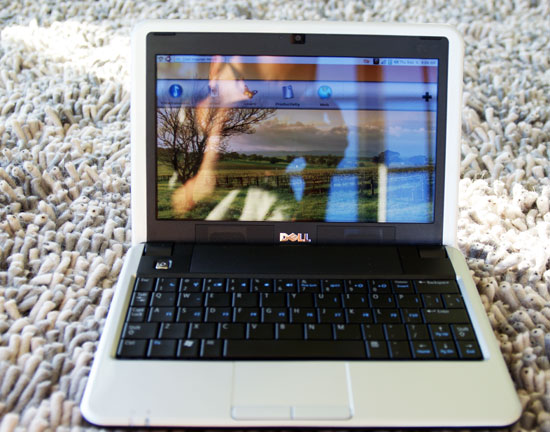Dell Inspiron Mini 9 Reviewed: Refining the Netbook Market
by Anand Lal Shimpi on September 4, 2008 12:00 AM EST- Posted in
- Laptops
Around 6 years ago I owned a Sony Picturebook C1VN. It was based on the horrendously slow Transmeta Crusoe TM5600 CPU, running at 600MHz - at the time it was about as fast as a desktop Celeron 400MHz.

Ah, my beloved Picturebook...how slow you were
(true story, some Intel folks made fun of me for pulling it out at IDF one year before Centrino hit)
The Picturebook was the first ridiculously impractical, but awesomely small notebook I ever owned. It was a pain to type on, slow and the screen was too cramped to get any serious work done. The size was its biggest selling point and for that you paid a premium, over $2,000 if I remember correctly, for the slowest, most impractical notebook you could buy at the time.
In my review of the ASUS Eee Box I talked about this idea of "fast enough" computers. That our desktop (and mobile) hardware has gotten so fast that it's paved the way for an entirely new category of computer, a machine that's not the fastest, but fast enough for things like web browsing and cloud computing. These days it's real easy to have all of your frequently used data stored in the cloud; emails in Gmail, documents online with Google Docs and all of your photos are already online if you like sharing them. You don't need an 8-core Nehalem to get access to your content stored in the cloud, you just need something fast enough.
Intel built its first "fast enough" processor, it's called Atom. Eventually we'll see Atom in smartphones but today it's in computers and mobile internet devices (MIDs). Combine this idea of fast enough hardware with the form factors that were popular during the Picturebook days and you get the netbook.
ASUS really kicked off this latest infatuation with netbooks with its Eee PC, but it’s sort of like what happened when Apple released the MacBook Air. Super thin, ultra portable notebooks had been released for years but since a company as high profile as Apple was now in the game it’s now exposed to a whole new crowd of people.
ASUS made tremendous headway with the Eee PC, bringing a notebook to users who had previously never heard of ASUS much less have any clue how to pronounce the name (AH-soose). But if it was ASUS who helped to create this recent phenomenon, it’s Dell that will make it popular.
Making the Case for Ultra Portables
It's called the Inspiron Mini 9 and it's Dell's entry into the netbook market. Make no mistake, ASUS was the driving force behind the Inspiron Mini 9. Even the naming is ASUS-inspired (the Inspiron Mini 910 vs. the Eee PC 901?). Despite ASUS' head start, Dell had the luxury of watching from a distance and improving where ASUS had failed to make enough changes.

I hate quoting the same review twice on one page but again, in the Eee Box article, I mentioned that it was the type of machine that if you had to ask yourself why you needed one, you probably didn't need to buy one. The Mini is quite similar. It's not practical enough to be a serious workhorse computer, it's what I would view as a 2nd, 3rd or 4th machine. It's something you add to the stable, not the only toy in the arsenal. Dell is even offering a promotion where they'll sell you a Mini for $99 if you buy it alongside some of its notebooks.

It's cute.
I've got a friend, her name is Anne, she works at Dell. I've worked with Anne for years, dating back to when I was still in highschool actually and while going over the Inspiron Mini 9 she recounted a story about her daughter. If you work for Dell and have children, I'd expect you'd get asked for free notebooks all the time. Anne does. She got her daughter a new Dell Studio notebook, but all her daughter does on it is browse the web and update her Facebook profile. Anne views the Inspiron Mini as the perfect notebook for her daughter, and I think I do too.
It's the kind of computer you'd take with you around town to browse the web on, but not for serious work. Writing quick blogs, posting on Facebook walls, IMing, catching up on Digg, are all things you could just as easily do on a smartphone - but it's easier to do on a netbook.
The netbook market exists because the perfect notebook/smartphone device hasn't been made yet. Notebooks aren't thin enough and smartphones aren't big/fast enough. The ultimate, ultra-thin Star Trek tablet just hasn't been invented yet and I suspect it's because we not only lack the UI but the hardware for it.
The Mini and netbooks like it are designed to fill a niche in your computing life, not to dominate it. With that established, let's look at the $349, 2.28 lbs, Dell Inspiron Mini.










55 Comments
View All Comments
Klug - Friday, September 5, 2008 - link
Thanks for the review.Maybe I misread but I could not find any info about the external PSU... How fat is it?
I currently use a M1330 and the external PSU is a pain (big, heavy, thick cable, etc).
Netbook is nice but when used "on the road" (ie: train, meetings, etc), it needs to be carried with its PSU. If the PSU is fat, that's bad.
benlen - Friday, September 5, 2008 - link
I missed this my self. An is a important information an a netbook.I found the answer here: http://www.youtube.com/watch?v=5M37j5BnERw">http://www.youtube.com/watch?v=5M37j5BnERw
about one minute in.
I am happy with the type.
They say it is 2.6 lbs with the psu so the psu should be about 0.4 lbs.
But I still havent found a picture on the UK psu. I hope it will be a travle type where you can change the plugs/connectors
I am by the way selling my M1330 to only have a mini 9 and a stationary
strafejumper - Friday, September 5, 2008 - link
i've been researching lappys for a week trying to buy my first one.found one i love from lenovo 15.4" but the one problem is all 15.4" lappy's that i've been looking at seem to have the exact same florescent lcd and when i went to circuit city to look at some they all looked very dim because of the vertical viewing angle.
Then i was in a local shop and they had a macbook air and it was totally different, many times brighter and still bright even at angles. Looking for a cheaper laptop than the macbook air now that has this good an led lcd. May have to wait a while.
wvh - Thursday, September 4, 2008 - link
Looks interesting, especially the passive cooling... But as someone who works in several countries, I think they made a mistake with their peculiar keyboard layout. It's not easy to get used to all the different international layouts, laptop- vs. full-sized keyboards, model-specific multimedia- and function-keys, and having manufacturers come up with their own proprietary layout on top of that makes their product much less appealing to me.
JoshuaBuss - Thursday, September 4, 2008 - link
nice carpet, anand! :)alpine18 - Thursday, September 4, 2008 - link
The dell sounds interesting, but I'll keep my eeepc 901 for now. I love this thing.It is great to see so many new netbooks in the market place. When they come out with a new netbook with the dual-core Atom, I'll probably buy one.
I differ with the article author's view on battery life and use. My eee 901 has effectively replaced my full size Gateway laptop. The thing sits at home since I got my 901, little more than a glorified portable desktop. I use my 901 all day without having to recharge, take it to meetings so I can act like I am taking notes when I am actually catching up on other work.
For me, the deal breaker for the Dell would be the battery life and 1GB memory. I have 2GB of memory in my 901 and need the 5-8 hours of battery life. If the Dell had the same battery life as the 901 and was upgradeable to 2GB, I'd seriously be thinking about getting one.
MamiyaOtaru - Thursday, September 4, 2008 - link
Glossy Screen? Why? So I can see what's behind me better than what I'm working on? Especially for a portable computer that just might be used outside, a reflective screen is dumb.I know glossy screens sell better in brick and mortar stores, but people are dumb (ooh, shiny!)
Nice to have a choice I suppose, so those who like it can get the Dell and I can get something else. But that's my point really, I'd get something else.
abakshi - Thursday, September 4, 2008 - link
Dell seems to have done better than I expected, but I'd be curious to see how you'd compare with the HP 2133 Mini-Note in terms of build quality, keyboard, screen, etc.I have a Mini-Note (C7 1.6 / 2GB / 120GB 7200rpm / Vista Business), and while granted, most configs are priced higher than the average netbook, the design is awesome and it's built better than any HP/Dell/etc. laptop I've ever seen. More importantly, the keyboard's light-years ahead of the EeePC and all other netbooks I've encountered thus far, and with a nice bright 1280x768 screen, it's a pleasure to work with on the go.
Roy2001 - Thursday, September 4, 2008 - link
1. Dual core Atom.2. Power saveing Poulsbo chipset + HD decoding feature.
3. Smooth HD/BD movie play back.
4. Has at least 8GB SSD built in and a SDHC slot so I can insert a cheap 32GB SD card (some day) as 2nd HD.
5. Has mini-HDMI output.
5. Built-in camera should be standard.
6. 1GB RAM should be standard.
7. 10" LCD with 1280x800 resolution.
8. Bluetooth built in so I can use a wireless mouse/keyboard without a dongle.
The more I can dream is touch screen, wireless USB hub, and more...
Matt Campbell - Thursday, September 4, 2008 - link
I'm really impressed with what Dell has done with the Mini, they struck a great balance with price/features and it looks fantastic. Thanks for the suggestions - the Wind, Aspire and Lenovo S10 are on my review wish list as well. Keep your eyes peeled for an upcoming HP 2133 Mini-Note review. Hopefully between Anand, Jarred and I we'll cover everything eventually :)